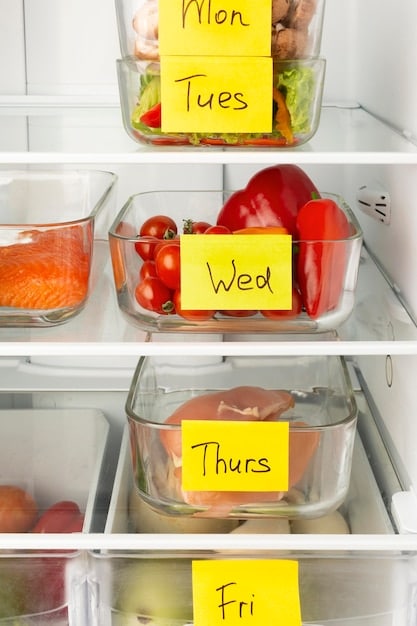Slash Your Grocery Bill by 15% in 3 Months: Meal Planning 2025

Strategic meal planning is a proven method to slash your grocery bill. By implementing effective techniques in 2025, such as inventory management, thematic meal nights, and leveraging seasonal produce, you can reduce your spending on groceries by 15% in just three months.
Are you tired of seeing your grocery bills skyrocket each month? The secret to financial freedom in the kitchen lies in **strategic meal planning**, and in this 2025 edition, we’ll show you exactly how to slash your grocery bill by 15% in just three months.
Understand Your Current Spending Habits
Before diving into meal planning, it’s crucial to understand where your money is currently going. This initial assessment will reveal areas where you can make immediate improvements and provide a baseline to measure your progress.
Track Your Spending for a Month
Start by meticulously tracking every grocery purchase for a month. Use a notebook, spreadsheet, or a budgeting app to record each item and its cost. This detailed record will highlight your spending patterns and identify areas where you might be overspending.
Identify Spending Patterns
Once you have a month’s worth of data, analyze your spending patterns. Are you buying a lot of pre-packaged snacks? Do you frequently purchase items that end up going to waste? Identifying these patterns is the first step towards making informed changes.

Here are some key areas to consider:
- Impulse Buys: Note any unplanned purchases. These are often the easiest to eliminate.
- Wasted Food: Track items that expire before you can use them. This indicates a need to buy less or plan meals around those ingredients.
- Brand Preferences: Compare the cost of name-brand items versus generic or store-brand alternatives.
By understanding your current spending habits, you’ll be better equipped to create a meal plan that addresses your specific needs and challenges, setting the stage for significant savings.
Create a Weekly Meal Plan
The heart of strategic meal planning is creating a structured weekly menu. This plan serves as a roadmap, guiding your grocery shopping and reducing the likelihood of impulsive decisions. A well-thought-out meal plan can drastically cut down on both food waste and spending.
Theme Your Nights
Consider theming your nights to simplify decision-making. For example, you could have “Meatless Monday,” “Taco Tuesday,” or “Pasta Wednesday.” This approach reduces the mental load of meal planning and allows you to reuse recipes and ingredients.
Check Your Inventory First
Before creating your meal plan, take inventory of what you already have in your fridge, freezer, and pantry. Plan meals that utilize these items to reduce waste and avoid buying duplicates. This step alone can lead to considerable savings.
Key benefits of inventory checks include:
- Reduced food waste
- Lower grocery bills by using what you have
- More creative meal ideas from existing ingredients

Plan for Leftovers
Intentionally plan for leftovers. Cook extra portions of dinner and use them for lunch the next day. This reduces the need to buy or prepare separate lunches, saving both time and money.
By creating a comprehensive weekly meal plan, you can take control of your grocery shopping and ensure that you’re only buying what you need. This strategic approach is fundamental to achieving a 15% reduction in your grocery bill.
Shop Smart at the Grocery Store
Strategic shopping is just as important as strategic planning. Once you have a meal plan, it’s time to head to the grocery store with a clear mission. By adopting a few smart shopping habits, you can avoid common pitfalls and stay within your budget.
Stick to Your Grocery List
The most crucial tip for smart shopping is to stick to your grocery list. Avoid wandering aimlessly through the aisles, as this increases the temptation to make impulse buys. A well-organized list ensures that you only purchase what you need for your planned meals.
Shop Seasonally
Shopping for produce that is in season can significantly reduce your grocery bill. Seasonal fruits and vegetables are typically cheaper and taste better, as they are locally sourced and readily available. Research which produce is in season in your area and incorporate them into your meal plan.
Compare Prices
Take the time to compare prices between different brands and product sizes. Unit pricing, which shows the cost per ounce or pound, can be particularly helpful in identifying the best deals. Don’t assume that larger sizes are always cheaper; do the math to be sure.
Here are some strategies to help you compare prices effectively:
- Check Unit Prices: Look for the price per ounce or pound to compare different sizes and brands.
- Compare Brands: Consider store brands, which are often cheaper than name brands but offer similar quality.
- Use Coupons and Discounts: Leverage coupons, loyalty programs, and store discounts to save even more.
By shopping smart and staying disciplined, you can make the most of your grocery budget and avoid unnecessary spending. These habits are essential for achieving your goal of a 15% reduction in your grocery bill.
Cook at Home More Often
One of the most impactful ways to reduce your grocery bill is to cook at home more often. Eating out or ordering takeout can be significantly more expensive than preparing meals yourself. By increasing the frequency of home-cooked meals, you can save a substantial amount of money.
Prepare Batch Meals
Consider preparing batch meals on the weekends to have ready-to-eat options during the busy workweek. Batch cooking involves making large portions of meals that can be stored and reheated, reducing the temptation to order takeout on hectic evenings.
Master a Few Simple Recipes
Focus on mastering a few simple, versatile recipes that you enjoy. These can become your go-to meals when you’re short on time or energy. The more comfortable you are in the kitchen, the more likely you are to choose home cooking over eating out.
Key benefits of cooking at home include:
- Control over ingredients and portion sizes
- Healthier meals with fewer processed foods
- Significant cost savings compared to eating out
Involve the Family
Make cooking a family affair. Involving your family in meal preparation can make it more enjoyable and educational. It also teaches valuable cooking skills and encourages healthier eating habits.
By committing to cooking at home more frequently, you can take control of your food spending and enjoy healthier, more affordable meals. Cooking at home is a cornerstone of strategic meal planning and a critical step in reaching your savings goal.
Minimize Food Waste
Food waste is a significant drain on your grocery budget. According to the USDA, approximately 30-40% of the food supply in the United States is wasted. By taking steps to minimize food waste, you can save money and contribute to a more sustainable lifestyle.
Store Food Properly
Proper food storage is essential for extending the shelf life of your groceries. Use airtight containers to store leftovers and perishable items. Store fruits and vegetables in the crisper drawer of your refrigerator to maintain their freshness.
Understand Expiration Dates
Learn the difference between “sell by,” “use by,” and “expiration” dates. Many foods are still safe to eat after the “sell by” date. Understanding these dates can prevent you from throwing away perfectly good food.
Here are some practical tips for reducing food waste:
- Plan Meals Based on Expiration Dates: Prioritize using ingredients that are nearing their expiration dates.
- Freeze Leftovers: Freeze leftovers in individual portions for easy reheating.
- Compost Food Scraps: Compost vegetable scraps, coffee grounds, and eggshells to reduce landfill waste and create nutrient-rich soil for your garden.
Embrace Imperfect Produce
Don’t shy away from slightly bruised or misshapen produce. Often, these items are just as nutritious and flavorful as their perfect-looking counterparts but are sold at a discount. Many grocery stores now offer “ugly” produce at reduced prices.
By implementing strategies to minimize food waste, you can significantly reduce your grocery bill and make the most of your purchases. Reducing waste is not only good for your wallet but also for the environment.
Monitor and Adjust Your Plan
Strategic meal planning is an ongoing process that requires regular monitoring and adjustment. What works one month might not work the next, so it’s important to stay flexible and adapt your plan as needed. Consistent monitoring allows you to refine your strategies and maximize your savings.
Track Your Progress
Continue tracking your grocery spending each month to monitor your progress. Compare your current spending to your baseline to see if you’re on track to achieve your goal of a 15% reduction. If you’re not seeing the desired results, identify areas where you can make further improvements.
Review and Revise Your Meal Plan
Regularly review and revise your meal plan to keep it fresh and exciting. Try new recipes, experiment with different ingredients, and incorporate feedback from your family. A dynamic meal plan is more likely to be sustainable in the long run.
Key aspects of monitoring and adjusting your plan include:
- Flexibility: Be prepared to adjust your plan based on sales, seasonal availability, and personal preferences.
- Experimentation: Try new recipes and ingredients to keep your meal plan interesting.
- Feedback: Solicit feedback from your family to ensure that the meal plan meets everyone’s needs and preferences.
Stay Informed
Stay informed about new trends and strategies in meal planning. Follow food blogs, read articles, and engage with online communities to learn new tips and tricks for saving money on groceries. The more informed you are, the more effective your meal planning will be.
By continuously monitoring and adjusting your plan, you’ll be able to fine-tune your strategies and achieve your long-term goal of reducing your grocery bill. This iterative process ensures that your meal planning remains effective and sustainable.
| Key Point | Brief Description |
|---|---|
| 💰 Spending Analysis | Track spending for a month to identify wasteful habits. |
| 🗓️ Weekly Meal Plan | Plan meals around inventory and thematic nights. |
| 🛒 Smart Shopping | Stick to your list, shop seasonally, and compare prices. |
| 🧑🍳 Home Cooking | Cook more at home, leveraging batch meals and simple recipes. |
FAQ
▼
Start small by planning just a few meals per week. Use time-saving techniques like batch cooking and prepping ingredients on the weekend. Gradually increase the number of planned meals as you become more comfortable with the process.
▼
Involve your family in the meal planning process. Ask for their input and incorporate their favorite dishes into the plan. Be willing to compromise and try new things, but also respect individual preferences and dietary restrictions.
▼
Plan meals based on what you already have in your fridge and pantry. Store food properly to extend its shelf life. Use leftovers creatively and consider composting food scraps to minimize waste and maximize your resources.
▼
Opt for budget-friendly options like lentil soup, vegetable stir-fries, and pasta dishes with homemade sauce. Incorporate seasonal produce and buy in bulk when possible. These meals are not only nutritious but also easy on the wallet.
▼
Review your meal plan at least once a month to keep it fresh and effective. Adjust it based on your budget, preferences, and any changes in your schedule or dietary needs. This will ensures long-term success.
Conclusion
By following these strategic meal planning tips, you can effectively slash your grocery bill by 15% in just three months. Start by understanding your spending habits, creating a detailed meal plan, shopping smart, cooking at home more often, minimizing food waste, and continuously monitoring and adjusting your plan to reach your financial goals.





